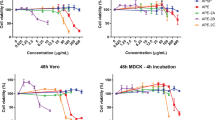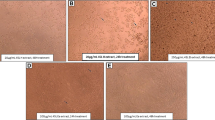Abstract
In this study, we evaluated the inhibitory effect of ethanol and aqueous extracts from a stem of Opuntia ficus indica on replication of three kinds of viruses: two enveloped viruses [herpes simplex virus type 2 (HSV-2), influenza A virus (IFV-A)], and one non-enveloped virus [poliovirus type 1 (PV-1)]. Only ethanol extract from the cactus stem showed significant antiviral activity in vitro. Two chlorophyll derivatives, pheophorbide a and pyropheophorbide a, were isolated as active substances exhibiting potent virucidal effects on HSV-2 and IFV-A, but no activity against PV-1 was observed. These findings suggest that these active compounds might recognize specific glycoproteins of enveloped viruses, precluding their binding to host cell receptors and inhibiting viral infections.




Similar content being viewed by others
References
Domingo E (1998) Quasispecies and the implications for virus persistence and escape. Clin Diagn Virol 10:97–101
Laurenz JC, Collier CC, Kuti JO (2003) Hypoglycaemic effect of Opuntia lindheimeri Englem in a diabetic pig model. Phytother Res 17:26–29
Trejo-González A, Gabriel-Ortiz G, Puebla-Pérez AM, Huízar-Contreras MD, Munguía-Mazariegos MR, Mejía-Arreguín S, Calva E (1996) A purified extract from prickly pear cactus (Opuntia fuliginosa) controls experimentally induced diabetes in rats. J Ethnopharmacol 55:27–33
Fernandez ML, Trejo A, McNamara DJ (1990) Pectin isolated from prickly pear (Opuntia sp.) modifies low density lipoprotein metabolism in cholesterol-fed guinea pigs. J Nutr 120:1283–1290
Fernandez ML, Lin ECK, Trejo A, McNamara DJ (1994) Prickly pear (Opuntia sp.) pectin alters hepatic cholesterol metabolism without affecting cholesterol absorption in guinea pigs fed a hypercholesterolemic diet. J Nutr 124:817–824
Park EH, Kahng JH, Lee SH, Shin KH (2001) An anti-inflammatory principle from cactus. Fitoterapia 72:288–290
Lee JC, Kim HR, Kim J, Jang YS (2002) Antioxidant property of an ethanol extract of the stem of Opuntia ficus indica var. saboten. J Agric Food Chem 50:6490–6496
Zou DM, Brewer M, Garcia F, Feuganag JM, Wang J, Zang R, Lieu H, Zou CP (2005) Cactus pear—a natural product in cancer chemoprotection. Nutrition 8:4–25
Ahmad A, Davies J, Randall S, Skinner GR (1996) Antiviral properties of extract of Opuntia streptacantha. Antivir Res 2–3:75–85
Sakdarat S, Shuyprom A, Na Ayudhya DT, Waterman PG, Karagianis G (2008) Chemical composition investigation of the Clinacanthus nutans Lindau leaves. Thai J Phytopharm 15:2549–2551
Suzuki T, Midonoya H, Shioi Y (2009) Analysis of chlorophylls and their derivatives by matrix-assisted laser desorption/ionization-time-of-flight mass spectrometry. Anal Biochem 309:57–62
Zhang HJ, Tan GT, Hoang VD, Hung NV, Cuong NM, Soejarto DD, Pezzuto JM, Fong HHS (2003) Natural anti-HIV agents. Part IV. Anti-HIV constituents from Vatica cinerea. J Nat Prod 66:263–268
Chansakaow S, Ruangrungsi N, Ishikawa T (2009) Isolation of pyropheophorbide a from the leaves of Atalantia monophylla (ROXB.) CORR. (Rutaceae) as a possible antiviral active principle against Herpes simplex virus type 2. Chem Pharm Bull 44:1415–1417
Almela L, Fernandez-lopez JA, Roca MJ (2000) High-performance liquid chromatographic screening of chlorophyll derivatives produced during fruit storage. J Chromatogr 870:483–489
Hankins WA, Hearn HJ (1970) Direct assessment of viral aerosols on cell cultures. Appl Microbiol 20:284–285
Detrick-Hooks B, Borsos T, Rapp HJ (1975) Quantitative comparison of techniques used to measure complement mediated cytotoxicity of nucleated cells. J Immunol 114:287–290
Jahiel RI, Kilbourne ED (1966) Reduction in plaque size and reduction in plaque number as differing indices of influenza virus-antibody reactions. J Bacteriol 92:1521–1534
Acknowledgments
This work was supported by JICA (Japanese International Cooperation Agency). The authors graciously thank JICA for their financial and logistical supports. The authors are grateful to Ines Karkour (Center of Biotechnology of Borj Cedria), Lassaad Chouba (National Institute of Marine Science and Technology, La Goulette) and Lamia Trabelsi (National Institute of Marine Science and Technology, Monastir) for their contribution in the lyophilization of plant materials.
Author information
Authors and Affiliations
Corresponding author
Rights and permissions
About this article
Cite this article
Bouslama, L., Hayashi, K., Lee, JB. et al. Potent virucidal effect of pheophorbide a and pyropheophorbide a on enveloped viruses. J Nat Med 65, 229–233 (2011). https://doi.org/10.1007/s11418-010-0468-8
Received:
Accepted:
Published:
Issue Date:
DOI: https://doi.org/10.1007/s11418-010-0468-8




